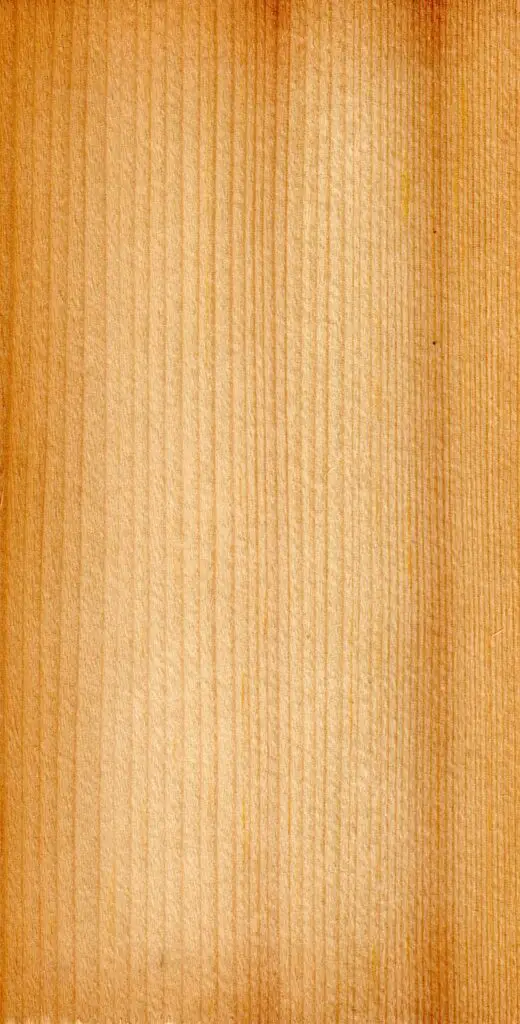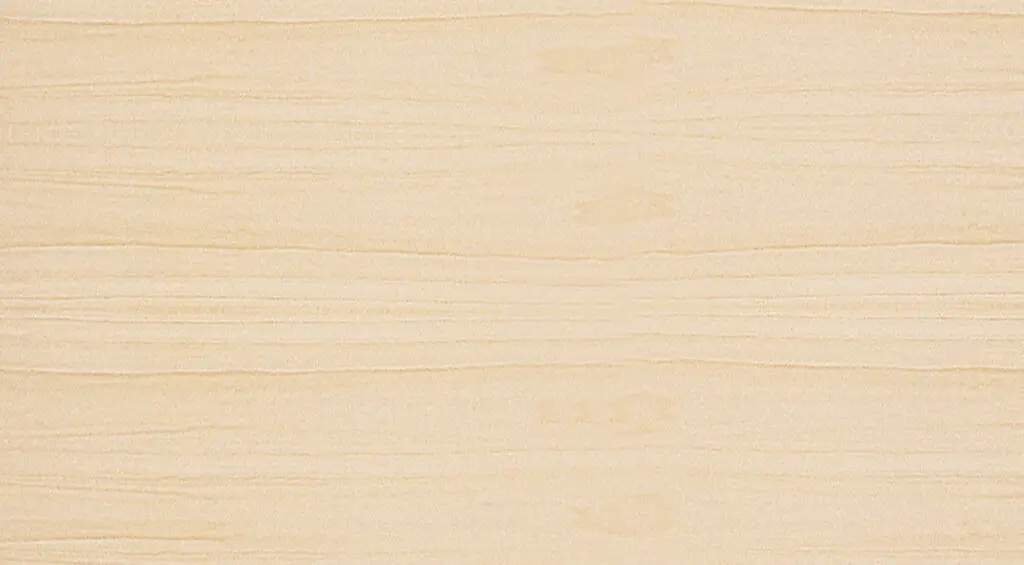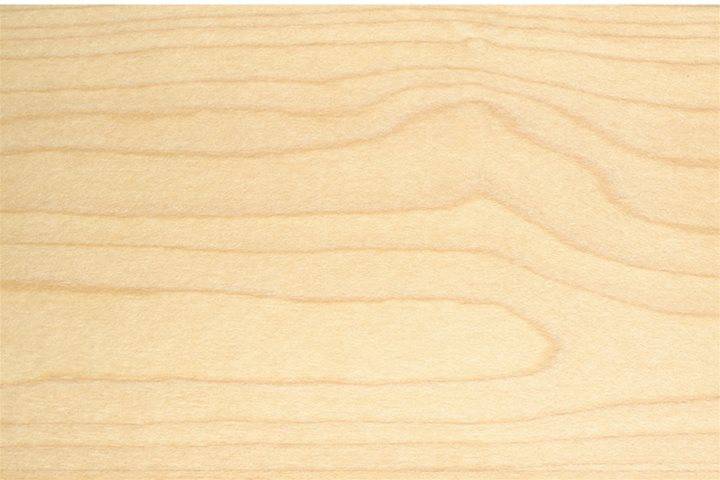The color of the wood can play a major role in the look and feel of the end product. Choosing the right color is not a task that can be taken without any thought.
If you’re looking for light-colored wood, we’ve made your research pretty easy for you.
Here, we will be talking about 10 light-colored wood that is coveted by woodworkers around the globe.
1. Maple Wood
Maple as you can see above is a creamy white hardwood with a reddish tinge. It is a hardwood and is one of the perfect options for heavy-use items.
Its color is preferred for reasons like:
- Versatility: Its light color makes it a versatile wood that can be used in a variety of styles and design schemes, from traditional to modern.
- Brightness: Its light color reflects light well, giving it a bright and airy appearance that can make a room feel more spacious.
- Easy To Stain: Maple’s light color also makes it easy to stain to achieve a desired shade or hue. This makes it a popular choice for custom finishes.
- Timeless: Light-colored woods like Maple have a timeless and classic appeal that never goes out of style.
| Aspect | Description |
|---|---|
| Locality | Grows Primarily in North America, particularly in the northeastern United States. |
| Color | Light-colored wood that ranges from nearly white to a light reddish-brown. |
| Grain | Fine, uniform texture & a straight grain that is sometimes wavy or curly. |
| Janka Hardness | 1. Can be relatively expensive. 2. It Can be difficult to stain evenly. |
| Pros | 1. Durable. 2. Resistant to scratches & wear. 3. Beautiful appearance. 4. Easy to shape and work with. |
| Cons | 1. Can be relatively expensive. 2. It Can be difficult to stain evenly. |
| Uses | Furniture, Flooring, Cabinetry, and other decorative applications. |
2. Ashwood
Ashwood is a hardwood that is light in color and smooth-grained. It is naive to Europe, Asia Minor, and Africa.
You can choose to have this wood for your wooden work mainly because,
- Light Color: Like Maple, Ashwood has a light color that is versatile and can work with a variety of design styles. It ranges from a creamy white to a light brown, with occasional pink or grey undertones.
- Beautiful Grain: Ashwood has a unique grain pattern that can vary from straight to swirling, giving it a distinctive appearance. This grain pattern is often enhanced through staining and finishing.
| Aspect | Description |
|---|---|
| Locality | North America, Europe, and Asia. |
| Colour | Light to medium brown, sometimes with a reddish tint. |
| Grain | Straight, with occasional wavy or curly patterns. |
| Janka Hardness | 1320 lbf |
| Pros | *Durable and Strong. *Resists wear and tear Easily. *Good shock resistance. |
| Cons | *Can be difficult to work with due to its hardness. *Can be expensive in certain regions or varieties. *Ash trees are threatened by the Emerald Ash Borer beetle. |
| Uses | Flooring, Furniture, Sports equipment, Tool handles, Millwork, Cabinetry, Musical instruments, etc. |
3. Pinewood
Pinewood is a softwood native to Northern Hemisphere. It has a fine, uniform texture that is easy on the eyes and the hands.
Pinewood is often preferred for its natural color because it has a light, neutral tone that can easily complement a variety of different design styles and color schemes.
Its natural grain and texture can also add visual interest and depth to the furniture
| Aspect | Description |
|---|---|
| Locality | Native to North America, Europe, and Asia. It is commonly grown and harvested in countries such as Sweden, Finland, and Canada. |
| Color | Light, pale yellow colour with a subtle grain pattern. It can sometimes have a reddish or brownish tint as well. |
| Grain | Straight, even grain pattern with a relatively uniform texture. |
| Janka Hardness | 380 lbf |
| Pros | 1. Affordable. 2. Easy to work with. 3. Light neutral color. 4. Easy to harvest. |
| Cons | 1. Prone to dents & scratches. 2. Susceptible to Cracking. 3. Not much durable. |
| Uses | Flooring, Furniture, Paneling, Packaging, Millwork, Cabinetry, Musical instruments, etc. |
4. Birchwood
Birch is a deciduous tree that belongs to the Betulaceae family, which includes other trees such as alder and hazelnut.
Birch is considered one of the best light-colored hardwoods. The several reasons include,
- It has a pale, creamy color that ranges from nearly white to light yellow, making it an attractive choice for furniture, flooring, and decorative objects.
- Birch wood can be easily stained or finished to match a wide range of design styles, from traditional to modern.
- It can be used to create a clean, contemporary look when left natural or stained with a light, clear finish.
- The color of birch wood can make it easier to notice the wood grain pattern and figure, adding a natural and organic look to furniture or decorative objects.
- Birch wood’s light color can also help to reflect light, making it ideal for smaller or darker rooms that need a bit of brightening up.
| Aspect | Description |
| Locality | Found in various parts of the world, including North America, Europe, and Asia. |
| Color | Pale, creamy color that ranges from nearly white to light yellow. |
| Grain | Straight, with a fine, even texture. |
| Janka Hardness | 1260 lbf |
| Pros | 1. Attractive light colors can create a bright and airy feeling in a space strong. 2. Durable hardwood Can take a stain or finish well Relatively affordable. |
| Cons | 1. Susceptible to insect damage and rot if not properly treated. 2. More difficult to work with than softer woods. |
| Uses | Furniture, flooring, cabinetry, millwork, turnings, decorative objects, plywood, pulpwood, and veneer. Birch is also used for traditional medicine, as its bark contains a compound called betulin, which is believed to have anti-inflammatory and anti-tumor properties. |
5. Oakwood
Oak is one of the most popular hardwoods used in furniture and flooring. Coming to the color and appearance of oakwood, it has a natural color that is often described as golden or beige. The color is not only pretty to the eyes but also has advantages such as,
- Versatile: Oakwood’s light color makes it a versatile material that can be used in a variety of design styles. It can be paired with other light woods for a Scandinavian look or contrasted with darker colors for a dramatic effect.
- Resistant To Yellowing: Unlike some other light-colored woods, oakwood is resistant to yellowing over time, which helps to maintain its light and bright appearance. This means that oakwood furniture can retain its light color for years to come with proper care and maintenance.
- Easy To Maintain: Oakwood’s light color is also easy to maintain, as it can be cleaned with a damp cloth and mild soap. This makes it a practical choice for furniture and flooring in high-traffic areas or homes with children and pets.
| Aspect | Description |
|---|---|
| Major Varieties | American Oak, European Oak, Japanese Oak, White Oak, Red Oak, Live Oak |
| Locality | Mainly in North America. |
| Grain | Straight grain (Some of the varieties have tight/open grain) |
| Janka Hardness | 1260 to 2,680 lbf |
| Pros | 1. Durable. 2. Resists wear and tear. 3. Affordable & available. |
| Cons | 1. Susceptible to water damage. 2. Can be difficult to work with. 3. Prone to splitting. |
| Uses | Furniture, flooring, Cabinets, and Boatbuilding |
6. Beechwood
Beechwood is a light to medium-weight hardwood that is known for its strength, hardness, and fine, even texture. It has a pale cream color with a straight grain that is sometimes marked by dark, brownish flecks. Beechwood has a very desirable color and also it is,
- Natural Pale Color: Beechwood has a pale cream color that is highly sought after for its natural, understated look.
- Uniformity of Color: Unlike some other light-colored woods that may have inconsistent coloration or visible knots, beechwood has a fine, even texture that results in a uniform appearance.
- Takes Stain Well: While beechwood’s natural color is often appreciated, it can also be stained to achieve a variety of darker hues. Beechwood’s ability to take stain evenly and well makes it a versatile choice for many different types of woodworking projects.
| Aspect | Description |
|---|---|
| Major Varieties | American beech, European beech, Japanese beech, & Chinese beech. |
| Locality | Europe, North America, & Asia. |
| Grain | Straight, even grain |
| Janka Hardness | 1300 – 1,450 lbf |
| Pros | 1. Hard. 2. Strong & Durable. 3. Easy to work with. |
| Cons | 1. Not as durable as other hardwoods. 2. More expensive than some other woods. |
| Uses | Furniture, flooring, Cabinets, toys, musical instruments, chopsticks, joinery, and more. |
7. Holly wood
Holly wood is a dense, fine-grained hardwood that is typically a pale, creamy white color. It is known for its ability to be worked and carved easily, as well as its strength and durability.
Its appealing light color makes it highly prized and coveted. Its color has several advantages including,
- Consistency: Unlike some other light-colored woods that may have inconsistent coloration or visible knots, holly wood has a fine, even texture that results in a consistent appearance.
- Accepts Dyes Well: Holly wood is highly receptive to dyes and stains, allowing for a range of beautiful color variations to be achieved while still maintaining its distinct light color.
- Reflects Light Well: The light color of holly wood has the ability to reflect light, creating a luminous effect that can enhance the overall appearance of the woodwork. This makes it a popular choice for decorative carving and inlays, where the play of light can showcase the intricate details and patterns of the wood.
| Aspect | Description |
|---|---|
| Locality | Eastern US. |
| Grain | Fine, & Even texture. |
| Janka Hardness | 1020 lbf |
| Pros | Inlays, handles, veneers, tool handles, decorative items, etc. |
| Cons | 1. Not widely available. 2. More expensive than some other woods. |
| Uses | Inlays, handles, veneers, tool handles, decorative items etc. |
8. Spruce wood

Spruce wood is a softwood that is known for its light color and fine, even grain. It is typically pale white or yellowish-white in color, with a straight, uniform grain pattern.
- Pale white or yellowish-white color: Spruce wood is naturally a very light color, ranging from pale white to yellowish-white, making it a desirable choice for projects that require a light and bright aesthetic.
- Takes stain and paint well: Spruce wood is easy to finish and takes stain and paint well, allowing it to be easily customized to achieve a range of colors and finishes while still maintaining its light color.
- Creates a warm and inviting atmosphere: The light color of spruce wood can create a warm and inviting atmosphere, making it a popular choice for interior design and home decor projects. The lightness of the wood can help to brighten up a space, making it feel more spacious and airy.
| Aspect | Description |
|---|---|
| Locality | Northern US, Canada, Europe |
| Grain | Fine, even texture |
| Janka Hardness | 340 lb. force |
| Pros | 1. Light and strong. 2. Easy to work with. 3. Takes finishes well. |
| Cons | 1. Relatively soft and prone to denting and scratching. |
| Uses | Construction, musical instruments, paper production, paneling, furniture, interior design. |
9. Poplar Wood

Poplar wood is a versatile and popular hardwood that is known for its light color and straight, uniform grain. It is typically a pale yellowish-white color, with a smooth texture and a fine, even grain pattern.
- Takes Paint Well: Poplar wood is known for its ability to take paint well, and its smooth surface and even texture make it an excellent choice for painted finishes. This allows poplar wood to be easily customized to achieve a range of colors and finishes while still maintaining its light color.
- Minimal Natural Variations: Poplar wood is generally free from the knots and other natural variations that are often found in other light-colored woods, which can create a clean and uniform look in finished projects.
- Complements Other Materials: Due to its light color and minimal natural variations, poplar wood can be easily paired with other materials such as metal, glass, or darker woods, allowing it to add a complementary lightness to a variety of different design styles and aesthetics.
| Aspect | Description |
|---|---|
| Locality | Eastern US. |
| Grain | Pale yellowish-white to light greenish-brown. |
| Janka Hardness | 540 lbf |
| Pros | 1. Lightweight and strong. 2. Easy to work with. 3. Takes paint well. |
| Cons | 1. Low natural durability. 2. Relatively soft. 3. Prone to scratches and dents. |
| Uses | Furniture, cabinetry, millwork, musical instruments, carving, paper production, painted finishes, etc. |
10. Sycamore Wood

Sycamore wood is a type of hardwood that comes from the sycamore tree, a deciduous tree native to North America and Europe.
It is known for its light color, which can range from a creamy white to a pale yellowish-brown, and its fine, uniform texture.
- No Dark Streaks: Unlike some other light-colored woods, sycamore wood does not have dark streaks or other discolorations, which can detract from its light appearance.
- Accepts Finishes Well: Sycamore wood takes finishes such as stains, paints, and clear coats very well, allowing it to be easily customized to match a particular design aesthetic or color scheme.
- Natural Luster: Sycamore wood has a natural luster that can give finished projects a subtle sheen, adding to their visual appeal.
- Complements Other Materials: Due to its light color and uniform appearance, sycamore wood can be easily paired with other materials such as metal, glass, or darker woods, allowing it to add a complementary lightness to a variety of different design styles and aesthetics.
| Aspect | Description |
| Locality | North America & Europe. |
| Grain | Creamy white to pale yellowish-brown. |
| Janka Hardness | 770 lbf |
| Pros | 1. Uniform color. 2. Accepts finishes well. 3. Has natural Luster. 4. Complements Other Materials. |
| Cons | 1. Not as hard as some other woods. 2. May be prone to warping or splitting if not dried properly. |
| Uses | Cabinetry, furniture, musical instruments, turnery, carving, decorative objects, etc. |
Conclusion
In conclusion, the ten kinds of wood discussed in this essay are some of the best light-colored woods available for woodworking and other applications.
They each have unique properties, colors, and grain patterns that make them suitable for a wide range of uses.
Making an informed decision about the type of wood to use can be achieved by assessing its strengths and weaknesses, and how well it aligns with the desired outcome.

